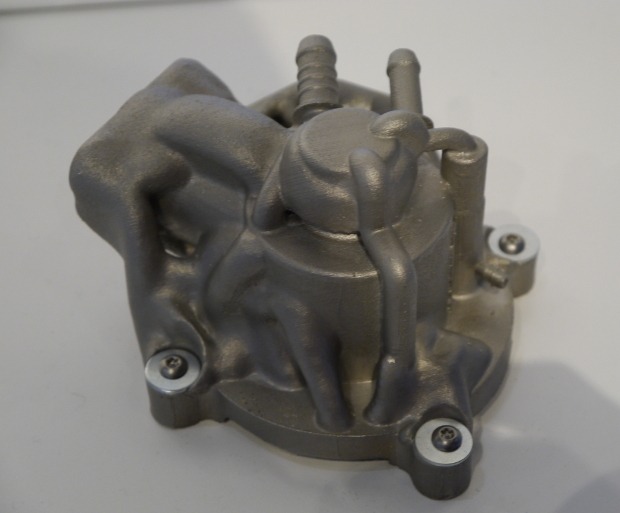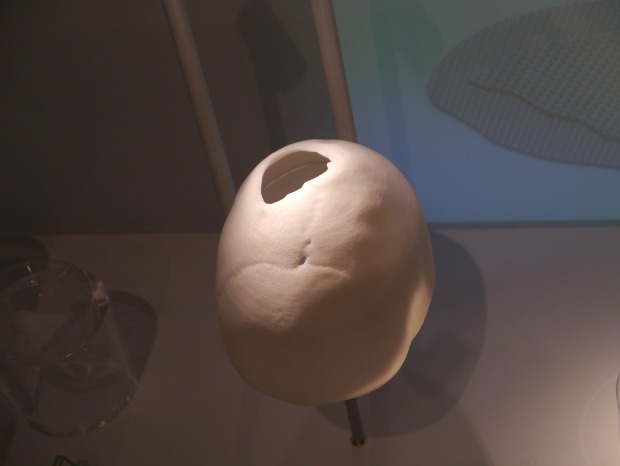
 This stainless steel car engine part to the right was created using a laser-sintering 3D printer.
This stainless steel car engine part to the right was created using a laser-sintering 3D printer.
While laser sintering printers are currently one of the priciest variety of 3D fabricators available, they also reduce waste as any unused metal powder can be reused.
Professor Dietmar Hutmacher from the University of Queensland in Australia used 3D printing to help repair a hole in a nine year old girl’s skull.
 The professor took a 3D scan of the girl’s skull and used it to design a 3D scaffold that could be placed in the missing piece of her skull.
The professor took a 3D scan of the girl’s skull and used it to design a 3D scaffold that could be placed in the missing piece of her skull.
Inside the scaffold was a precise network of channels that could hold bone cells and allow new tissue to grow. The scaffold was printed using biodegradable materials, which
meant after three years it dissolved, leaving new healthy bone that filled in the hole in her skull.
A new exhibition has opened in London to show off the multitude of uses that are being found for 3D printers. View 10 more astonishing images & descriptions of what 3D printers have done HERE
The impact of 3D printing on manufacturing will be as profound as the Industrial Revolution by the estimation of some tech industry pundits.
Today there are certainly a growing number of industries building 3D models, with fields as diverse as aerospace and biotechnology finding a use for 3D printing.
Lower cost 3D printers are beginning to find their way into homes too, with 3D printers priced at around £1,000 available in office and computer stores, as well as shopping hubs like Amazon.
There’s also a burgeoning community of hobbyists building their own 3D printers based on open source designs, such as RepRap, and sharing designs for a wealth of objects through the online portalThingiverse.
Even more exotic uses of 3D printers are being researched, including machines that build bone using stem cells and that create objects out of wood filaments, cement polymer and salt.
“3D printing is really reaching out and touching everything. It’s comparable to the web in that it’s a technology that can be applied to whatever you want it for,” said Dave Marks, media and content director for 3D Printshow, which provided the printers for the show.
The breadth of what 3D printers can build was on show at the Science Museum in London, which yesterday opened an exhibit of more than 600 3D printed objects ranging from satellite sensors to prosthetic arms.
3D printing has several advantages over traditional manufacturing techniques. Building a model doesn’t require spending thousands or more to set up machine tools and then thousands more when you want to change that model. It makes it financially viable to build one-off models and to tweak and customise 3D models in a way that would rapidly become hugely expensive using traditional manufacturing methods. Making simple repairs to old household appliances, rather than replacing them, also becomes more viable when spare parts can be printed off in your living room, rather than having to be tracked down and ordered online. Using a 3D printer also cuts down the supply chain: the network of factories, warehouses and shipping companies normally needed to get a product to an end user.
3D printing can also build objects using novel materials with complex shapes and structures that would be extremely difficult to reproduce using traditional methods. General Electric recently revealed a 3D-printed ceramic and carbon fiber jet engine whose lightweight design should allow for fuel economy unmatched by conventionally made counterparts. Waste can be reduced as the printer is generally using only the materials needed to build the object, rather than carving material out of a larger structure to create an object.
But in general 3D printers are also slow, two-inch high figurines printed out at the Science Museum exhibition took about one hour to print, are far more expensive than traditional manufacturing techniques for mass production and consumer grade 3D printers are only able to produce relatively simple plastic models.
How 3D printers work
3D printers work by taking a 3D computer model and slicing it into layers. The 3D printer then builds the object layer by layer using one of a number of methods.
Most home and hobbyist printers print using Fused Deposition Modeling (FDM), which basically builds a model out of molten plastic. FDM machines feed plastic thread into a printer head, where the plastic is melted and squeezed out of a nozzle called an extruder. The head traces the outline of each layer, gradually building the model using melted plastic.
The quality of the finished model depends on many factors, including the quality of the base material, how thinly sliced the model is, the mechanics of the 3D printer and the care taken in preparing the 3D computer model.
Yet the quality of 3D models produced by FDM generally don’t match those built by some other more costly 3D printing technologies used by industry. One such technology is laser sintering.
Laser sintering uses a laser to fuse powder together into the model. The process works by tracing the outline of each each layer onto powdered material using a laser to fuse the object together layer by layer. Laser sintering is able to reproduce fine details and build models out of a wider range of materials than FDM, such as ceramics, metals and glass.
While the FDM printers available to novice home users today generally produce relatively simple models in a single colour and material, more advanced machines are becoming available.
The quality of 3D printers available to home users is expected to take a leap forward from next year after patents run out on key technologies related to laser sintering, which in the long run may make sintering machines affordable for the home user.
View 10 more astonishing images & descriptions of what 3D printers have done HERE












